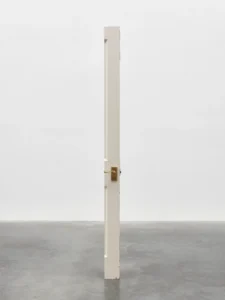by Elizabeth Ashe
 The architectural turn at exhibits that I viewed at Art Basel, Scope and Untitled created a show different than others in Miami during Miami Art Week.
The architectural turn at exhibits that I viewed at Art Basel, Scope and Untitled created a show different than others in Miami during Miami Art Week.
At Art Basel Miami, White Cube’s double space included a sculpture by Christian Marclay “Vertical Cuts (White Door)” (2023). I am very much a fan of Bachelard, and doorways as just another form of interior space. In the sculpture several door segments were crosscut and secured together, taking up the width of the stable, solid wood of one door, but six doors deep. There’s an air gap between the doors, enough to see light through or peep at someone. Even at a slice, these doors have weight, and I feel like I could depend on them.
Poligrafia exhibited four massive etchings by Iran de Espírito Santo titled “Venecians.” Each etching block was hand cut then hand placed. Each is slightly different in tint, one leaning green, one mauve, one black, one blue requiring an effort to discern. They are based on Venetian window shutters, with clean lines and color, saturated like so much stone and wood.I imagine these tones dreams of the canal, looking up through the water at night, the colors of cold, resting wood. Galeria Sur and Tornabuoni Arte represented Pablo Atchugarry. His Carrara marble sculptures have a different voice than traditional marble – they are all energy, all directions forming into an expanding column. And there is no figure. All the energy pushes out and into and against itself. This is what I imagine Minimalism would look like if it wanted to try on a Baroque mask.
At Scope, the installation at the entrance by Tomislav Topić, “Offset” spanned the apex, placing both tent and beach horizon together. Using 22 color tones on painted mesh, the overall effect is more “like a hologram,” letting the eye see more colors based on angles and time of day. In the center, the doorway pole spliced the two together creating an upper angle, sweeping up like for a circus tent in an old cartoon. It’s a welcoming awe to the Scope tent, and the title leaves it open – what is offset? The tent, offset from the beach, vice versa, the power of color instead of white walls, or the layered surfaces of the installation, one hemmed shorter than the next from back to front?
Decay and fragments surfaced in unexpected ways. At Untitled, El Apartmento (based in Madrid) showcased a piece by Diana Fonseca, “Untitled, From the series Degradation,” 2023. At first glance, it’s another abstraction where red centers the eye, taking over a field of neutrals and blue-greens. A bulls-eye poppy, as it were. But more importantly, the first glance is just the grab. The colors are rips of paint freed off a wall. It is timeless, and I want to gently run my fingers over all the edges and think about all the days these paint chips have seen. Portas Vilaseca exhibited several works by Mano Penalva. Penalva uses wood and rattan cane, and “delves into the heart of everyday life, displacing objects from their usual context and reflecting on the material culture and the social interactions within different spaces.” While woven cane is considered a craft and furniture design structural element, it lives inside architecture and often complements it. Penalva treated it with great respect and in some cases, as an architectural relief. By removing cane from chairs, he elevates the handiwork of weaving it, coloring it, abstracting it down to different shapes. And in several pieces of his “Essays” series, includes fraying cane. The unraveling is gorgeous in this context, and not something to repair or cover over. The result is very modern, the geometric abstractions made by taking these surfaces and putting them into a new one every day.
I appreciated the unexpected twists of looking at framed and sculptural works for what they were saying about architecture and the passage of time on those materials. All of these works captured something of light through a given space. All these works wanted me to build, take a walk down a shaded street, enjoy a sunset, just outside.
